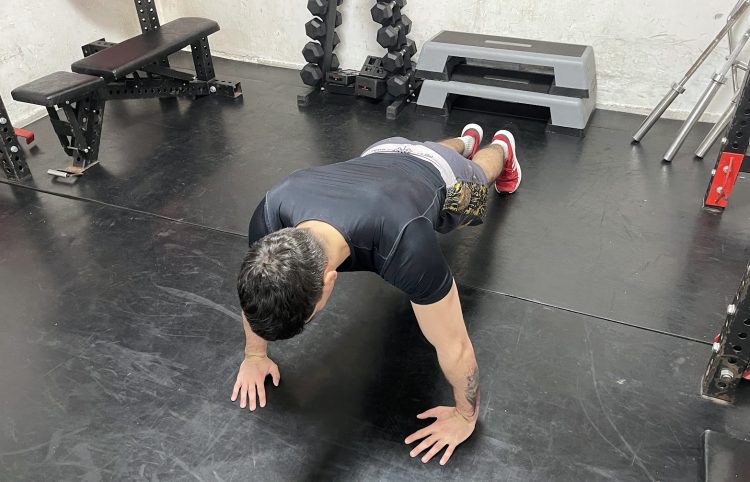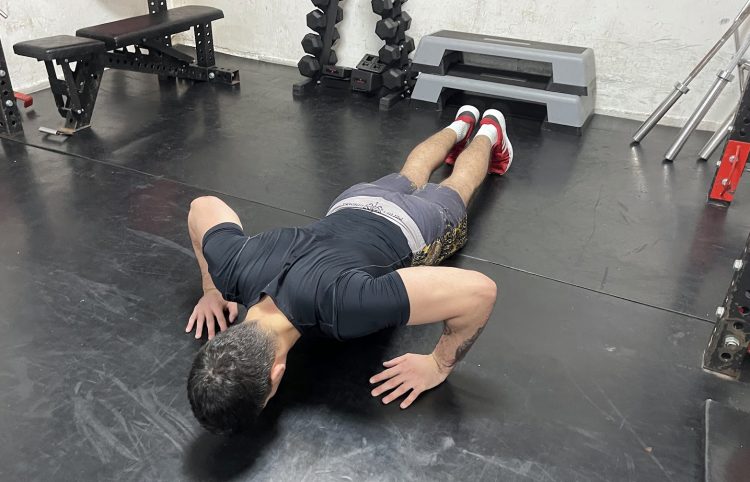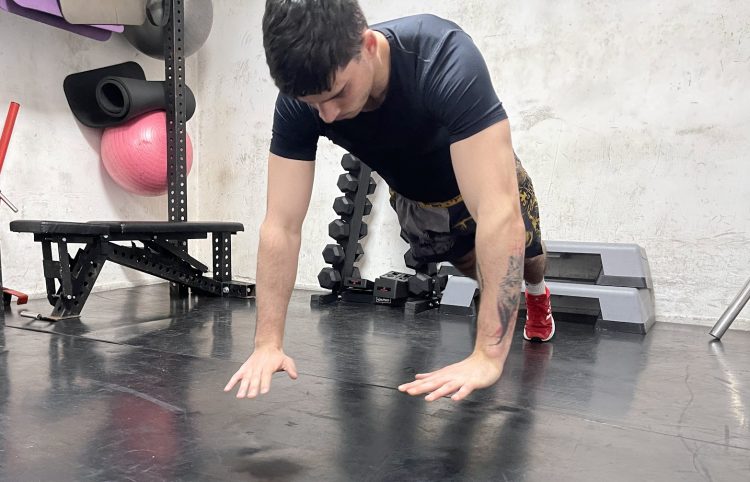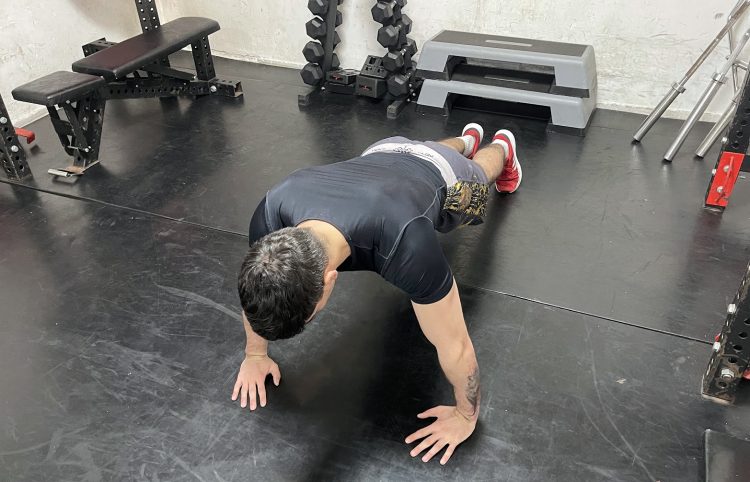Plyometric push-ups can significantly benefit your power and strength development. They require substantial contraction of your fast-twitch muscle fibers and are excellent for athletes and regular gym-goers.
I regularly implement plyo push-ups in my contrast training sessions, pairing them with a heavy bench press or similar exercise. Post-activation potentiation (PAP) happens right after lifting close to your 1RM. It allows you to perform plyo push-ups even better.
Let’s start with a simple guide about performing plyo push-ups properly so we can maximize the benefits of this amazing exercise.
How To Do Plyometric Push-Ups
Just to be clear, the guide below illustrates how to perform a single rep of plyometric push-ups. However, if you want to string a few of these together, you can repeat the steps outlined in this guide. We will stick with the one-rep method to make this guide as simple and beginner-friendly as possible.
Step One — Assume the Starting Push-up Position
Assume the high plank position with your hands just outside shoulder width, and make sure your elbows are fully extended. Keep your core contracted and your spine neutral. Also, keep your head in a neutral position; no need to look. It will help avoid some specific neck strains later on.
Pro Tip: If you are doing these for the first time, you might feel uncomfortable during the landing phase. That’s why I always recommend that my clients perform plyometric push-ups on a mat until they become more comfortable.
Step Two — Quickly Lower Your Body Towards the Floor
Flex your elbows to lower your torso toward the floor. This phase focuses on accumulating maximal force for later use in the concentric phase.
Pro Tip: Imagine holding the ground with your hands and pulling yourself towards it. This will ensure you lower as quickly as possible and accumulate the most force for the next phase.
Step Three — Explosively Push Yourself off the Ground
Push yourself off the ground as explosively as you can by forcefully extending your elbows and driving your body toward the ceiling. Your hands should be clear off the floor at the top of the range of motion (ROM).
Pro Tip: The trick to getting the biggest push off the ground lies in effectively using something called the stretch-shortening cycle (SSC). During the previous phase, we set the stage for SSC by rapidly driving our body towards the floor. Now, we can use the stored elastic energy in our muscles by quickly reversing the movement and moving our body upwards.
Step Four — Land in the Bottom Push-up Position
Softly land on the ground and absorb the force with your chest, shoulder, and triceps. Proper eccentric phase mechanics are crucial here, not just to avoid injury but also to be able to perform another plyo push-up.
Pro Tip: Advanced exercisers should strive for maximum hand elevation, while beginners should aim to lift their hands safely off the floor by a few inches.
Step Five — Return to the Starting Push-up Position
After you land, slowly return to the starting position and repeat the process.
Pro Tip: I advise you to perform this last phase slowly as you want to preserve extra energy for the explosive phase of the exercise.
Plyometric Push-Ups Muscles Worked
The primary muscles working are the pectoralis major, triceps brachii, and anterior deltoid.
The secondary muscles include external obliques, serratus anterior, rectus abdominis, and some additional shoulder and back muscles.
Plyometric Push-Ups Benefits
Here are the most important plyometric push-up benefits:
Explosive Strength (Power) Development
Plyometric push-ups are perfect for explosive strength development. They will improve your upper body pushing power, especially in the horizontal pushing movement pattern. This can translate to better performance in sports such as basketball, handball, and grappling sports. (1)
Improved Punching Power
Even though punching efficacy and effectiveness depend highly on the proper striking technique, explosive strength still plays a crucial role. Plyometric push-ups are perfect for making punches more explosive and even harder to see coming.
However, more experienced fighters will likely need to perform weighted plyo push-ups for added upper-body strength development.
One of the studies found a particularly useful correlation between four weeks of plyometric training and punching power endurance in boxers. (2)
Development of the Primary Horizontal Pushing Muscles
In terms of biomechanical and planes of motion analysis, the push-up belongs to the horizontal push movement pattern. This is important because our upper body has four of these, including horizontal push and pull and vertical push and pull.
Explosive push-ups are perfect for developing pushing strength in the horizontal plane, which can be useful for numerous sports and even on a day-to-day basis. The target horizontal pushing muscles include the pectoralis major, triceps brachii, and front deltoids.
Improved Stretch-Shortening Cycle (SSC)
The stretch-shortening cycle is the ability of muscles to quickly return to their original length after being stretched. The key is stretching it to the right length and with speed.
Why?
This elasticity of muscles enables us to use it as free energy that we can convert into higher vertical displacement in terms of plyo push-ups. The more we stretch the muscle in the shortest period possible, the more energy we store that can be used for the following phase of the exercise.
Most Common Mistakes and How to Prevent Them
Here are the most common mistakes during plyometric push-ups and how to prevent them.
Overarching Your Lumbar Spine (Lumbar Lordosis)
Overarching your lumbar spine can lead to some serious injuries and muscle strains in your back and hip muscles.
Luckily for you, it’s really simple to fix. All you need to do is contract your core musculature, including your abdominal and hip muscles, which will fixate your spine in the sagittal plane of motion.
Not Keeping Your Entire Body Stiff
One of the most common mistakes I see way too often during just about any push-up variation is failing to treat the body as a single unit. This is primarily the result of not keeping your body stiff enough. To do that, you must contract the muscles of your entire body.
This is why I always emphasize that push-ups are a whole-body movement, not just an upper-body movement. Push-ups differ from, let’s say, bench press variations in that you need to keep your body steady and solid during the entire exercise so you can perform the horizontal pushing motion using your upper body.
During bench press variations, you don’t need to bother with that since the bench provides all the stability and support you need. But that’s also why push-ups are considered more functional than lying bench presses. Keep your body stiff, and contract the muscles of your entire body to ensure proper plyo push-up technique.
Going Too Deep
Going too deep can prevent you from generating optimal force, resulting in the most significant vertical displacement. That’s why I suggest finding the optimal range of motion just somewhere before the bottom position for the best possible results. You must experiment with different positions to find the most optimal position for your body mechanics.
Plyometric Push-up Variations
Here are the best plyometric push-up variations you should add to your exercise arsenal;
Clapping Push-Ups
Clapping push-ups are essentially the same as regular plyo push-ups, except you add the clapping during the vertical displacement phase. Notably, there is no substantial scientific evidence suggesting that the clapping motion adds more value in terms of gains during plyo push-ups.
However, they are a nice variation to avoid monotony, and it’s somewhat more satisfying to hear the clapping motion during each rep.
Steps:
- During the vertical displacement phase, quickly clap and return your hands to their normal position on the ground just before you land.
Pro Tip: Immediately after getting off the floor, focus on getting your hands together for the clap.
Deficit Plyometric Push-up
Deficit plyometric push-ups primarily focus on the concentric phase of the exercise, where you don’t need to absorb much force at the end because of the limited ROM.
Steps:
- Picking two steppers of the same height is recommendable for beginners. Avoid balls and other similar objects in the beginning to avoid injury.
- Land softly on the objects of your choice after the vertical displacement phase and repeat.
Pro Tip: Start with smaller, solid, and the same objects to avoid inconsistencies and developing muscle imbalances that could lead to injuries. Once you become more proficient with the exercise, you can experiment with different types of gear.
Depth Plyometric Push-Ups
Depth plyometric push-ups are somewhat opposite to plyometric push-ups as they focus on the eccentrics.
Steps:
- Start on two steppers or any other elevated objects.
- Extend your elbows to explode off the steppers and place your hands on the floor.
- Quickly reverse the movement to return to the starting position.
Pro Tip: Like the previous variation, start small and progress gradually. Depth jumps, push-ups, and similar exercises are extremely taxing on your tendons, ligaments, and bones, meaning you must be extra careful with the level of difficulty you begin with.
Alternating Med Ball Plyometric Push-Up
Alternating medicine ball plyometric push-ups are a nice unilateral variation that will focus more on the explosive part of a single limb.
Steps:
- Put a medicine ball on the floor.
- Place your left hand on the ball and your right on the floor.
- Alternate hands by performing plyometric push-ups.
Pro Tip: Focus on quick switching between your hands to maximize upper body explosive strength development.
Plyometric Push-up Alternatives
Here are the best plyometric push-up alternatives.
Medicine Ball Chest Pass
The medicine ball chest pass is another excellent plyometric movement heavily used in athletic bouts and conditioning programs.
Steps:
- Pick a medicine ball and hold it in front of your chest.
- Rapidly extend your elbows to launch the ball forward.
- Do this as explosively as possible to throw the ball furthest away.
Pro Tip: Add a bit of hip hinge before throwing the ball for a more explosive whole-body movement.
Explosive Barbell Bench Press
The explosive barbell bench press is also suitable for developing upper body explosive strength, but it is slightly less functional than the previous medicine ball chest pass alternative.
Steps:
- Load the barbell with 30-70% of your 1RM (repetition maximum).
- Lie on the bench, unrack the barbell, and place it right above the level of your mid-chest.
- Quickly lower the barbell to the bottom position and, even faster, return it to the starting position.
- The aim is to move the barbell as quickly as possible from start to finish.
Pro Tip: Experiment with the width of your grip. Different grips allow you to develop different amounts of explosive strength.
FAQs
How do you progress to plyo push-ups?
To progress from regular to plyo push-ups, the best thing you can do is perform plyo push-ups from your knees. This will reduce the amount of power needed for vertical displacement while also being easier on your shoulder joints.
Do explosive push-ups build muscle?
Explosive push-ups can definitely build muscles. However, they aren’t the most optimal exercise to promote hypertrophy since you can’t do a lot of them, and if you can, you just aren’t using adequate loading for optimal hypertrophy effects.
Expert Opinion on Hypertrophy Benefits of Plyometric Push-Ups
In a YouTube video, natural bodybuilder, powerlifter, and science-based fitness content creator Jeff Nippard shared his opinion about plyometric push-ups.
“Plyometric push-ups are too cardio intensive and don’t target the chest enough to promote hypertrophy. You have to do many reps (50 or more) to get to muscle failure, and you won’t start to feel your chest until rep 20 or 30, meaning the earlier reps are wasted energy for muscle building.” — Jeff Nippard
Are explosive push-ups better than regular push-ups?
Explosive push-ups are better than regular push-ups for more athletic workouts and building explosive power. Otherwise, I would stick with regular push-ups or alternate between them.
Wrapping Up
Plyometric push-ups are generally a good option for developing upper body power and strength. They are excellent for almost all types of athletes, including team sports such as handball and basketball, grappling, and mixed martial arts.
I personally do plyometric push-ups periodically as a part of my power-focused mesocycle. This is the most optimal way to get the best bang for the buck regarding effort and results.
In the comments below, let me know how often you perform plyometric push-ups and how you implement them in your workout routines.
References:
- Kons RL, Orssatto LBR, Ache-Dias J, et al. Effects of Plyometric Training on Physical Performance: An Umbrella Review. Sports Med Open. 2023;9(1):4. Published 2023 Jan 10. doi:10.1186/s40798-022-00550-8
- Bruzas V, Kamandulis S, Venckunas T, Snieckus A, Mockus P. Effects of plyometric exercise training with external weights on punching ability of experienced amateur boxers. J Sports Med Phys Fitness. 2018;58(3):221-226. doi:10.23736/S0022-4707.16.06674-3
Relevant Articles:
منبع: https://fitnessvolt.com/plyometric-push-ups-guide/




